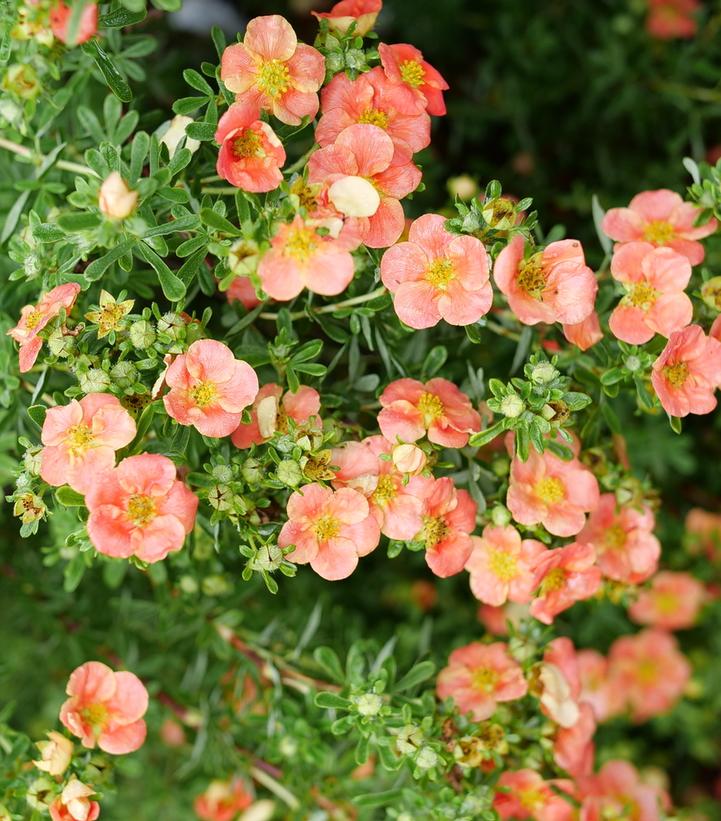Common Name: Happy Face® Hearts Potentilla
Bloom Time: Late spring through frost (May–October)
USDA Zones: 2–7 (exceptionally hardy in Southeast Wisconsin)
Mature Size: 2–3 ft. tall × 2–3 ft. wide
Habit: Compact, rounded shrub
Flower Color: Cheerful yellow to orange blooms with soft red highlights
Introduction
When many shrubs are finishing their show, Happy Face® Hearts Potentilla is just getting started. Blooming reliably from late spring until the first frost, this tough, sun-loving shrub offers a months-long display of cheerful flowers against tidy green foliage. Known for its resilience, adaptability, and ease of care, it’s one of the most versatile flowering shrubs for Wisconsin gardens. Whether you’re planting a pollinator-friendly border, a foundation accent, or a low-maintenance landscape design, this potentilla delivers season-long color with very little upkeep.
Heritage Hill Nursery offers several outstanding potentilla selections, including Happy Face® Orange Potentilla—a close cousin with the same carefree performance and vibrant blooms. Explore it here:
https://heritagehillnurseryinc.com/product/potentilla-fruticosa-happy-face-orange/
Origins & Description
Potentilla, sometimes called shrubby cinquefoil, is native to cooler regions of the Northern Hemisphere, where it thrives in open meadows, prairies, and mountain slopes. Bred selections like Happy Face® Hearts were introduced to improve both flower size and color vibrancy while maintaining the species’ rugged toughness.
The shrub’s dense, mounded habit makes it an excellent choice for low hedges, mixed borders, or mass plantings. Each bloom is a bright splash of yellow-orange with red undertones, producing a warm, glowing effect that shifts with the angle of the sun. The fine-textured, fern-like foliage stays fresh and green all summer, even in hot or dry spells, giving the plant ornamental value long after peak bloom.
Ideal Growing Conditions (Southeast Wisconsin Focus)
-
Light: Full sun is best—at least 6 hours per day ensures maximum blooms.
-
Soil: Adaptable to a wide range of soils, from sandy to clay. Good drainage is essential.
-
Moisture: Once established, it is quite drought-tolerant. Regular watering the first year promotes strong root systems.
-
pH: Tolerates acidic to slightly alkaline soils (pH 5.5–7.5).
-
Hardiness: Withstanding Wisconsin winters down to –40°F, it’s one of the hardiest flowering shrubs available.
Planting & Establishment
Timing: Best planted in spring or early fall. Both allow roots to establish before stress from summer heat or deep winter cold.
How to Plant:
-
Dig a hole twice the width of the container and equal depth.
-
Place shrub so the crown sits level with the surrounding soil.
-
Backfill with native soil, firm gently, and water thoroughly.
-
Apply a 2–3 inch mulch layer around the base, keeping mulch 2 inches away from stems to prevent rot.
Spacing: Plant 2–3 feet apart if used in groupings or as a hedge to allow air circulation and natural form.
Care & Maintenance
-
Watering: Water deeply once a week during dry spells in the first year. Mature plants are drought-tolerant and rarely need supplemental watering except in prolonged drought.
-
Fertilizer: Minimal needs. A light application of balanced fertilizer in spring promotes fresh growth and abundant bloom.
-
Pruning: After bloom, lightly trim to maintain shape. In early spring, remove any dead wood or weak stems to encourage vigorous new shoots.
-
Pests/Disease: Naturally resistant to most pests and diseases. Rarely troubled by deer or rabbits, making it an excellent choice for wildlife-heavy areas.
-
Longevity: With minimal care, potentilla can thrive for decades, making it a long-term landscape investment.
Propagation
Potentilla can be propagated by softwood cuttings in summer or by division in spring, although most gardeners prefer to purchase named cultivars to ensure flower color consistency.
Landscape Uses & Companions
-
Foundation Planting: Use as a colorful, low-growing shrub near the house, where its season-long bloom softens hard edges.
-
Mass Planting: Ideal for slopes or large open beds where you want a bright, continuous display of color.
-
Pollinator Gardens: Flowers provide nectar for bees, butterflies, and hoverflies.
-
Mixed Borders: Combine with shrubs like spirea, dwarf lilac, or ninebark for continuous bloom sequences.
-
Companions: Pairs beautifully with ornamental grasses, daylilies, salvia, and coneflowers.
Seasonal Calendar (Wisconsin)
-
April–May: Spring cleanup; light fertilizer.
-
Late May–June: First flush of flowers begins.
-
July–September: Continuous flowering with light deadheading or shaping.
-
October: Still blooming until frost; foliage remains attractive.
-
Winter: No care needed—shrubs rest quietly until spring.
Troubleshooting
-
Sparse Bloom: Usually due to too much shade. Move to a sunnier spot for more flowers.
-
Overgrown Shape: Can be rejuvenated by cutting one-third of the plant back in early spring.
-
Yellowing Leaves: Often a sign of waterlogged soil. Ensure good drainage.
Ecological & Garden Value
-
Pollinators: Supports local bee populations and provides nectar late into fall when other plants fade.
-
Wildlife Resistance: Deer and rabbits generally avoid it.
-
Low-Maintenance: A true “plant it and forget it” shrub once established.
-
Climate Resilience: Cold-hardy and tolerant of drought, heat, and poor soils, making it an all-star for challenging Wisconsin sites.
Ready to Plant?
If you’re looking for a carefree, long-blooming shrub that provides reliable color and pollinator value, Happy Face® Hearts Potentilla is an ideal choice. At Heritage Hill Nursery, you can also explore close relatives like the Happy Face® Orange Potentilla, available here:
https://heritagehillnurseryinc.com/product/potentilla-fruticosa-happy-face-orange/

